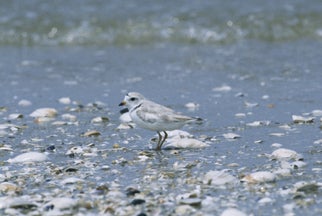SCIENTIFIC NAME: Charadrius melodus Ord
OTHER NAMES: Beach Plover, Sand Plover (Haig 1992).
STATUS:
Fairly common in winter, spring, and fall, and rare in late summer in Gulf Coast region. In other regions, occasional mostly in fall. Listed as threatened by the U.S. Fish and Wildlife Service. HIGHEST CONSERVATION CONCERN.
DESCRIPTION:
A small (17.0-18.0 cm [6.7-7.1 in.]) shorebird with pale gray to sandy-brown upperparts. Breeding adults show black shoulder patches, often forming a band crossing the breast and around back of neck. Forehead white with dark band crossing from eye to eye; whitish patch above and behind eyes. Bill short, stout, and orange with a black tip; legs orange-yellow; underparts and rump white. Juveniles and nonbreeders lack dark breast bands, have grayish patches on shoulders, a black bill, and legs not as brightly colored (Haig 1992). Typical call a clear peep or peep-lo (Haig 1992). While there is some debate on the validity of dividing the species into two subspecies, C. m. melodius and C. m. circumcincta, two breeding populations (Atlantic Coast and Interior, respectively) are recognized (Haig 1992).
DISTRIBUTION:
Atlantic coast population breeds from coastal North Carolina northward to Newfoundland in Canada. Interior birds found in the northern Great Plains from southeastern Alberta through southern Saskatchewan and Manitoba into southwestern Ontario in Canada and northwestern Minnesota south into the Dakotas, eastern Montana, southeastern Colorado, western Iowa, Nebraska, and northwestern Oklahoma. In the Great Lakes regions, nest locally along Lakes Superior and Michigan in northern Michigan (Haig 1992). Interior breeding birds likely winter along coastal Florida, west along the Gulf Coast, and south, but local, to the Yucatan Peninsula, Mexico. Atlantic coast breeding birds observed wintering from Virginia south to the Florida Keys, with sightings in the Bahamas and other islands of the Caribbean (Haig 1992). Interestingly, color-banded individuals found wintering in Alabama had their origins in South Dakota and Saskatchewan (pers. obser.).
HABITAT:
Interior breeding birds found in areas of sparse vegetation with gravel or sandy beaches near alkali lakes. Along river courses, use beaches, sandflats, and dredge islands. Atlantic Coast birds nest on foredunes and blow-out areas behind primary sand dunes. In the northern Atlantic states and Canada, gravel or cobble areas used. Dredge spoil sites also may be used for nesting. In nonbreeding areas along Atlantic Ocean and Gulf of America, use coastal beaches and barrier islands with expanses of mudflats and sand flats (Haig 1992, Evans 1999).
FEEDING HABITS:
Diet includes fly larvae, marine worms, and beetles (Imhof 1976).
LIFE HISTORY AND ECOLOGY:
Arrive on breeding grounds mid-March to early May. Males arrive first and soon establish territories that include feeding areas and potential nest sites. Territory sizes range from 0.4 hectare (1 acre) in Nova Scotia to more than three hectares (7.4 acres) in Saskatchewan. Distances between nests vary from around 15 meters (49 feet) in South Dakota to 100 meters (328 feet) in New Jersey. Nesting often occurs near tern colonies (Haig 1992). When courting females, males perform elaborate aerial displays as well as posturing, drumming of feet, and vocalizations. Males construct a simple scrape or depression in sand and may line nest with small pebbles or bits of wood or shells. Multiple scrapes may be constructed. Birds primarily monogamous, but usually a different mate is retained each season. Female chooses nest scrape where most copulations occur (Haig 1992). Egg clutch size normally four, with successive eggs laid every other day. Eggs light buff, with fine spots or splotches of brown or black. Multiple clutches can be laid as nests are destroyed. Both parents participate in incubation, which lasts around 28 days. After hatching, precocial young are mobile within several hours. Parents brood young up to 21 days. Young forage near parents and are able to fly at about 28 days of age (Haig 1992).
BASIS FOR STATUS CLASSIFICATION:
Hunting for millinery trade a major threat, primarily to Atlantic coast populations, in the nineteenth century; threat ended by passage of Migratory Bird Treaty Act of 1918. Now, major threats throughout distribution include habitat loss, disturbance, and predation. Populations have disappeared from Pennsylvania, New Hampshire, Wisconsin, Illinois, Indiana, Ohio, and Lake Ontario (Haig 1992). Current population estimate is 6,200 birds (Brown 2000). Partner’s In Flight (PIF ) data indicate piping plovers have the lowest relative-abundance ranking, a restricted breeding and nonbreeding distribution, threats to their breeding and nonbreeding habitat, and show a population decrease (PIF 2002). In Alabama, wintering populations have correspondingly declined. Where once more than 200 piping plovers had been seen (Imhof 1976), the maximum number of wintering birds at any one time typically is less than 40. In Alabama, limited to a few sites presenting optimal foraging conditions, with birds possibly present from August to May and peak numbers in winter. Little Dauphin Island, Pelican Island, and parts of Dauphin Island are traditional wintering sites. Currently Pelican Island is best site since the tidal flats of Little Dauphin Island and Dauphin Island have degraded in quality. Occasionally birds seen on western tip of Fort Morgan Peninsula, Baldwin County, around washover pools along the shoreline. In 2001, critical wintering habitat was designated in Alabama that encompassed the tidal zones, flats, and associated dune systems of Dauphin Island, Little Dauphin Island, Pelican Island, Isle Aux Herbes, and the western tip of the Fort Morgan Peninsula (U.S. Fish and Wildlife Service 2001). Atlantic Coast and Great Plains populations listed as threatened and Great Lakes populations listed as endangered by the U.S. Fish and Wildlife Service in 1985.
Author:
Roger Clay






